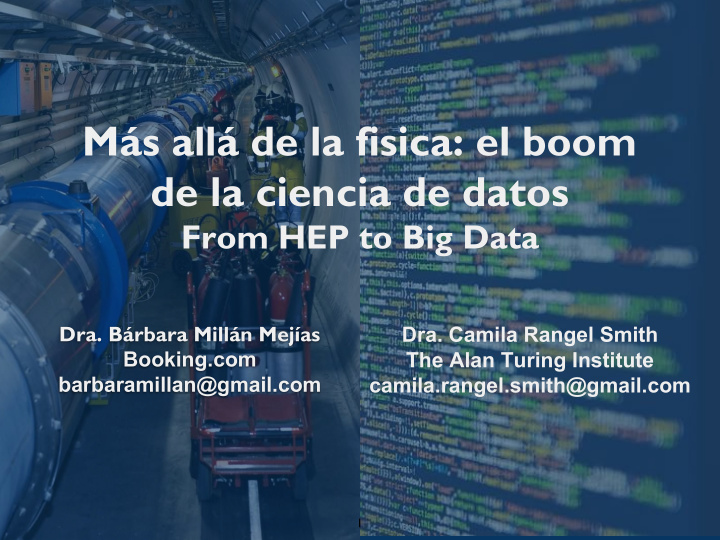



Más allá de la fisica: el boom de la ciencia de datos From HEP to Big Data Dra. Bárbara Millán Mejías Dra. Camila Rangel Smith Booking.com The Alan Turing Institute barbaramillan@gmail.com camila.rangel.smith@gmail.com 1
Our journey: From Venezuela to Science to Data Science Bárbara: ○ La Guaira ○ Bachelor Physics - USB ○ Master - Particles and Astroparticles UvA (ATLAS experiment/ CERN) ○ PhD - University of Zurich ○ CMS collaboration LHC @CERN ○ 5 years Booking.com ■ Data Scientist ■ Product Manager Data Science
Our journey: From Venezuela to Science to Data Science ● Camila: ○ Mérida ○ Bachelor Physics - ULA. ○ PhD Particle Physics in Université Paris Diderot (ATLAS experiment). ○ Postdoctoral fellow at Uppsala University (ATLAS experiment). ○ Data Scientist: ■ Digital Assess (2016-2018) ■ The Alan Turing Institute (present).
Data Scientist High-ranking professional with the training and curiosity to make discoveries in the world of big data. 4
5
● Define the questions What does ● Define the data sets ● Obtain the data a data ● Clean the data ● Exploratory data analysis scientist ● Statistical prediction or modeling ● Results interpretation do? ● Challenge results ● Synthesize and writes up results ● Create reproducible code ● Distribute results 6
What does a data Follows the scientific method scientist do? 7
● Statistical analysis Techniques ○ Bayesian/Frequentist ○ Statistical hypothesis ■ A/B testings e-commerce ● Simulations ● Machine learning ○ Linear regressions ○ Logistic regressions ○ Visualisation ● Time series analysis ● Deep learning ● Natural language processing 8
An example from e-commerce: Booking.com 9
Understanding families
30% of the searches done by ‘Family with Missing children children’ guests do not specify number of children
Hypothesis: People forget to add their children
Missing kids
At the stay review form, users tell ● us if they are a family, a group, solo or a couple Build a Machine Learning Model ● Role of machine that guesses the traveller type learning using information like location etc. Apply the treatment only when ● the model says the user is most likely a family.
A/B testing A/B testing is jargon for a randomized controlled trials with two variants, A and B , which are the control and treatment in the controlled experiment. Looking for statistically significants. 15
Base. Variant. Which one performed better? 16
An example of academy/industry collaborations: The Alan Turing Institute 17
About the institute ● UK national institute for data science and artificial intelligence. ● Collaborate with universities, businesses and public and third sector organisations to apply research to real-world problems. ● Break down disciplinary boundaries; at the Turing, computer scientists, engineers, statisticians, mathematicians, and scientists work together under one shared goal. 18
Safety of offshore floating facilities: Predicting the hazardous conditions faced by offshore oil and gas facilities, to inform and improve operational decision-making ○ Combination of tides and seabed shape around the continental shelf can lead to the formation of powerful ‘soliton’ waves, these are solitary non-linear waves that retain their shape and speed as they propagate. ○ Soliton waves can pose a hazard to offshore oil+gas facilities, particularly when loading/unloading to a tanker. 19 19 https://www.turing.ac.uk/research/research- projects/safety-offshore-floating-facilities
Safety of offshore floating facilities: Predicting the hazardous conditions faced by offshore oil and gas facilities, to inform and improve operational decision-making ○ Industry Question: i. What will be the maximum amplitude of the wave? ● ○ Oceanographers at UWA have a Partial Differential Equation solver to model solitons formation and propagation (Korteweg-de Vries equation for continuously stratified fluids). ○ At the Turing, researcher Nick Barlow (former ATLAS experiment) worked with statisticians at UWA to turn this into a probabilistic model, and visualize the output. 20 20 https://www.turing.ac.uk/research/research- projects/safety-offshore-floating-facilities
Safety of offshore floating facilities: Predicting the hazardous conditions faced by offshore oil and gas facilities, to inform and improve operational decision-making Combining the physics, statistics and computing for industrial impact: i. Probabilistic modeling: Monte Carlo simulations ii. Computationally demanding: Parallel, distributed and cloud computing iii. Software development: Necessary for industrial uptake 21 21 https://www.turing.ac.uk/research/research- projects/safety-offshore-floating-facilities
Conclusion ● The tools you have learnt and the statistical knowledge you are aware of can be used in different areas ● Keep an eye on the technologies advancing in the world: ○ Physics ○ Computer Science ○ Governments ○ Finance ○ Business ● Interdisciplinarity is in the essence of Data Science. Review the work done on different areas, it can inspire and drive your own study and research. 22
Free data science courses ● Coursera course on Data Sciencehttps://www.coursera.org/learn/data-scientists-tools ● Machine learning: Andrew NG Machile learning course on Standford for free ● http://datascienceacademy.com/free-data-science-courses/ ● https://www.codecademy.com/ Free coding courses 23
Recommend
More recommend